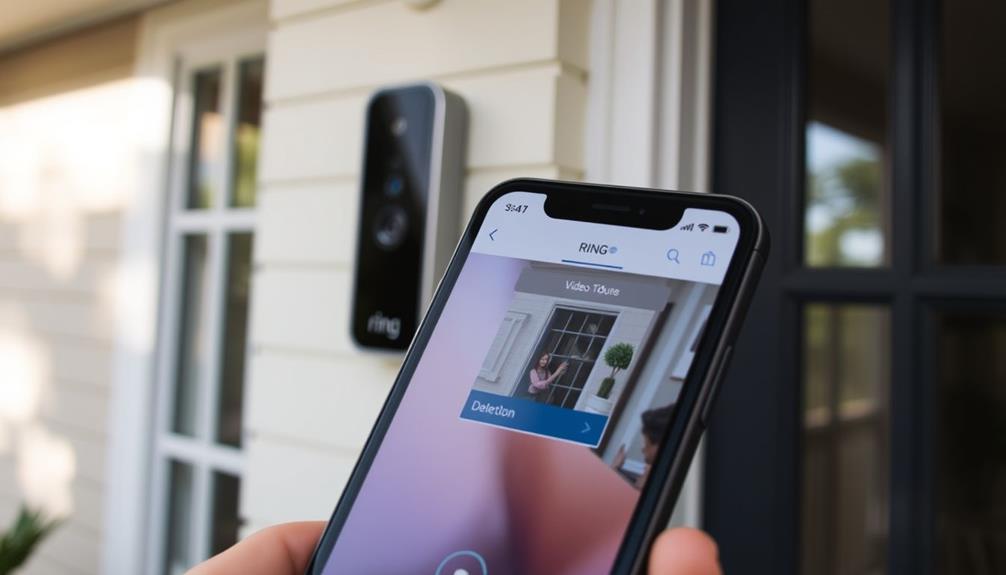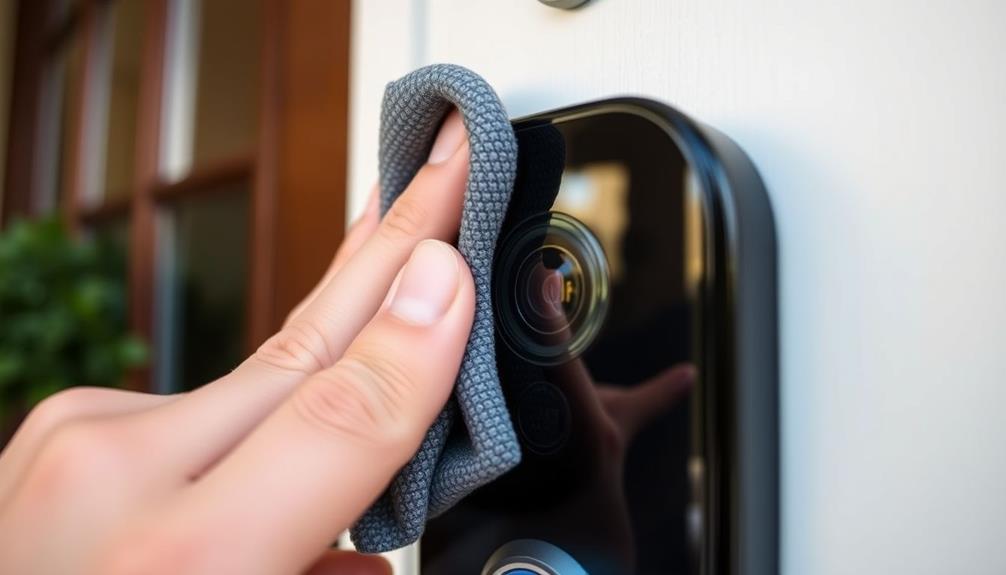To delete videos from your Ring Doorbell, open the Ring app and navigate to the Event History. For Android, swipe right on individual videos to select them, or use the "Delete All" feature for multiple deletions. If you're on a desktop, log into your Ring account, go to the Event History, and select videos to delete or use "Select All" to remove up to 94 at once. Remember, important clips should be downloaded first, as deletion is permanent. Keeping your storage organized makes it easier to find what you need and you might discover some tips that can enhance your experience.
Key Takeaways
- Open the Ring app or log into the Ring website to access your Event History for recorded videos.
- On mobile, swipe right on individual videos to select them for deletion.
- Use the "Delete All" option for bulk deletion of selected videos in the app.
- Confirm deletions to permanently remove videos; remember to download important clips first.
Why Delete Ring Videos
Regularly deleting unimportant Ring videos helps you manage storage space and keep your event history organized. By taking the time to delete unnecessary recordings, you free up valuable storage for new footage, guaranteeing your device operates efficiently. This practice of content management is essential for maintaining an organized digital space, as noted in potential topics may include industry news.
Establishing a routine for reviewing your videos every few days is imperative. This practice not only enhances your device's performance but also prevents clutter in your event history.
When you delete videos that aren't important, you make it much easier to find the significant recordings when you need them. Imagine scrolling through a long list of footage filled with trivial clips; it can be overwhelming and time-consuming. By managing your video storage proactively, you retain control over your recorded data. This means important clips won't get lost amid a sea of less relevant videos.
Additionally, keeping your Ring device uncluttered makes it simpler to navigate and retrieve the essential footage you want to preserve. Regularly sifting through your recordings guarantees that you're maximizing your storage capacity while safeguarding the important events that matter most to you.
Who Can Delete Videos
Only the primary account holder can delete videos from the Ring doorbell, guaranteeing control over your recorded footage. This strict access control is vital for maintaining your privacy and security, especially in a world where AI advancements raise significant privacy concerns.
Here's a quick breakdown of who can and can't delete recordings:
- Primary Account Holder: You have full permissions to delete videos and manage your Ring doorbell settings.
- Shared Users: These users can view your videos but lack the permissions to delete or modify any recordings.
- Neighbors by Ring Users: They can see shared videos but can't delete them, reinforcing your control.
- Importance of Access Control: By managing who's access to your recordings, you enhance community safety without compromising your personal data.
Understanding this hierarchy helps you maintain the security of your Ring doorbell recordings.
If you want to guarantee that your videos stay private and secure, it's vital to manage your shared users carefully. Always remember, only you, the primary account holder, can permanently delete those videos.
How to Delete Videos on the App

To manage your recorded footage effectively, you can easily delete videos directly from the Ring app.
First, open the app and navigate to the Event History list, where you'll see all your recorded footage. It's crucial to understand that using security systems like Ring can enhance your safety and peace of mind, as studies show homes with such systems are less likely to be targeted by burglars increased safety and peace of mind.
If you're using the Android app, simply swipe right on individual events to reveal checkboxes. This feature lets you select individual videos or multiple clips for deletion.
If you want to save time, you can use the "Delete All" option located at the bottom right of your screen for bulk deletion of selected videos. However, before you hit delete, make sure to download any important clips you want to keep, as deleted videos from Ring servers are permanently removed.
Deleting Videos on Desktop
Deleting videos from your Ring Doorbell on a desktop is straightforward and can be done through your Ring account at Ring.com. Effective keyword clustering and topic clustering can enhance your searchability for tutorials like this one.
Follow these simple steps to manage your Event History efficiently:
- Log In: Start by logging into your Ring account on your desktop.
- Navigate to Event History: Find the Event History section, where all your recorded videos are stored.
- Select Videos: Click on the individual videos you want to delete, or use the "Select All" option to delete multiple videos at once. Remember, you can only delete a maximum of 94 videos at one time.
- Confirm Deletion: Once you've made your selections, confirm the deletion. Be aware that these videos will be permanently removed from Ring's servers and can't be recovered.
Before you proceed with this deletion process, it's advisable to review and download any important videos you might need in the future.
Once deleted, you won't have access to them again. Taking these steps guarantees you manage your video storage effectively while maintaining access to crucial recordings.
Video Management Options

When it comes to managing your Ring videos, you've got several options at your fingertips.
You can easily delete videos individually or in bulk, control who's access to shared clips, and keep an eye on your storage space.
To enhance your home security experience, consider integrating best HVAC companies that can help maintain a comfortable environment while you monitor your video library.
Let's explore these video management methods to help you maintain a tidy and efficient video library.
Video Deletion Methods
Managing your Ring Doorbell videos is straightforward, allowing you to delete individual clips or clear out your entire event history with just a few taps. Implementing effective video management strategies is essential for maintaining ideal storage and ensuring your content remains relevant to your needs. Here are some effective methods you can use:
- Individual Deletion: Open the Ring app or Ring.com and navigate to your Event History. Swipe right on the videos you want to delete, and select them for removal. This way, you can manage your storage efficiently.
- Delete All Feature: If you're looking to remove everything at once, locate the "Delete All" option at the bottom right of the screen in the Ring app. Be aware that this feature may not be available to all users.
- Desktop Deletion: If you prefer using a computer, remember you can delete up to 94 videos at a time. Just select the clips you want to remove from the Event History.
- Download Important Clips: Before deletion, it's smart to download any important videos you want to keep, as deleted videos are permanently removed from Ring servers. For more insights into <a target="_blank" href="https://adsandseo.com">content credibility practices</a>, consider how to enhance the value of your video storage management.
Managing Video Storage
Regularly reviewing your video storage options helps guarantee you have enough space for new recordings while keeping only the footage that matters most to you.
Using the Ring app, you can manage your video storage efficiently by deleting unimportant videos from your Event History. Since Ring videos auto-delete after 60 days, it's important to stay proactive in managing your space.
Understanding how to maintain your digital assets can be as important as knowing key factors in choosing a home cleaning service.
You can delete videos individually or use the bulk deletion feature for a more streamlined approach. If you're accessing the Ring dashboard via desktop, you can delete up to 94 videos at a time, so plan accordingly to maximize your storage management.
This flexibility allows you to maintain control over your recordings, making sure you never run out of space for significant footage.
Before you delete any content, remember to download important videos you wish to keep, as deleted videos are permanently removed from Ring servers.
User Access Control
User access control in the Ring app guarantees that only the primary account holder can delete videos, safeguarding your recordings and privacy. This setup enhances video management while guaranteeing that your data remains secure.
In the context of cybersecurity, understanding the importance of user access control is vital for protecting sensitive information, as emphasized in cybersecurity measures. Here's how access control works:
- Primary Account Holder: You have full authority to delete any videos recorded by your Ring Doorbell, maintaining control over your footage.
- Shared Users: Those you invite can view videos but can't delete or modify them, guaranteeing the integrity of your recordings.
- Neighbor Access: People in your community can see videos you've shared but are also restricted from deleting any recordings, which promotes community safety.
- Video Retention Policies: Remember, videos automatically delete after 60 days unless you take action, encouraging regular oversight of your footage.
With this access control in place, you can feel confident that your privacy is protected while still contributing to community safety. By managing shared access effectively, you guarantee that everyone can benefit from the Ring Doorbell without compromising your personal data.
Community Feedback on Deletion
Many users find it frustrating to navigate the Ring app's interface when trying to delete videos.
Proper attention to detail is critical in understanding the various options available, but you might notice that options for video deletion aren't always clear, especially on Android devices.
There's a strong desire within the community for a simpler process, like using checkboxes for selection, to make managing your videos easier.
Additionally, feedback from users emphasizes the need for continuous updates to improve the overall user experience, which aligns with best practices in software quality assurance.
User Interface Challenges
Steering through the video deletion process in the Ring app often leaves users frustrated due to its confusing interface and lack of straightforward options. Users struggle to locate delete options within the Android app, often finding dropdown menus instead of a clear "Delete All" feature. This can lead to unnecessary delays and confusion, similar to maneuvering through the complexities of a modern farmhouse bedroom where every detail matters.
Here are some common challenges users face:
- Long-pressing events: This action reveals radio buttons for individual selection, which many find cumbersome.
- Checkboxes vs. radio buttons: Users prefer checkboxes for easier bulk deletion, yet the app's current interface doesn't accommodate this preference.
- Lack of bulk deletion: Many express frustration about the absence of a straightforward method for deleting multiple videos at once, complicating video management.
- Community discussions: Feedback from users highlights the need for improvements in app functionality to streamline the deletion process.
Desire for Simplified Process
Frustration with the video deletion process has sparked community feedback advocating for a more simplified and intuitive approach within the Ring app. Users want to easily delete videos without traversing through convoluted menus.
Many have expressed a strong desire for a "Delete All" feature that enables bulk deletion, making video management more efficient. Currently, the user interface can be confusing, with delete options often hidden in dropdown menus instead of being readily visible.
This lack of visibility complicates the process, especially when you're dealing with a large volume of footage. Clearer action icons and options are essential for enhancing your experience.
Community feedback emphasizes that a more straightforward process would greatly improve user satisfaction. By simplifying video management, you'd spend less time figuring out how to delete what you don't need and more time enjoying the peace of mind that comes with your Ring doorbell.
Implementing these changes could lead to a more user-friendly environment, ultimately making video deletion an easy task rather than a frustrating chore. It's time for the Ring app to listen and act on the growing demand for a more efficient deletion process.
Frequently Asked Questions
Can You Delete Ring Doorbell Footage?
Yes, you can delete Ring Doorbell footage.
As the primary account holder, you've got the authority to manage your recordings.
You can easily delete videos directly from the Ring app or website.
Just remember, once you delete them, they're permanently gone and can't be recovered.
It's wise to download any important clips before you hit delete, since videos are only stored for up to 60 days before they're automatically removed.
How Do I Delete Events on My Ring Doorbell?
Did you know that nearly 60% of homes with smart security systems use video doorbells?
To delete events on your Ring Doorbell, open the Ring app and head to the Event History.
Tap on the specific event you want to remove, then select the options menu and choose "Delete."
If you wish to delete multiple videos, swipe right on the events and select "Delete All."
Just remember, only the primary account holder can do this.
How to Remove Ring Doorbell Video?
To remove a video from your Ring Doorbell, start by opening the Ring app and heading to the Event History. To remove a video from your Ring Doorbell, start by opening the Ring app and heading to the Event History. From there, locate the video you wish to delete and swipe left on it or tap the three dots to reveal the delete option. While managing your video history, you can also explore the settings to disarm a Ring Doorbell temporarily, which disables motion alerts and recordings for added privacy. Always ensure to confirm deletions, as they are typically permanent and cannot be restored.
Tap on the video you want to delete, then hit the trash can icon.
If you need to delete multiple videos, use the "Delete All" option on the website.
How Do I Delete Posts on the Ring App?
To delete posts on the Ring app, you'll need to access the Event History.
Once there, find the specific post you want to remove.
If you're using the Android app, swipe right on the post to reveal options, including checkboxes.
You can select multiple posts for deletion.
Just remember, only you as the primary account holder can delete these posts, so shared users won't be able to make any changes.
Conclusion
To sum up, deleting videos from your Ring doorbell is as easy as pie—if pie were a complex digital task requiring a PhD in technology.
So, whether you're erasing evidence of that awkward delivery dance or just cleaning up your digital clutter, you've got the power.
Just remember, every time you hit delete, a little bit of your digital legacy fades away.
But hey, at least your privacy is a bit safer—until the next time you forget to turn off the camera!









